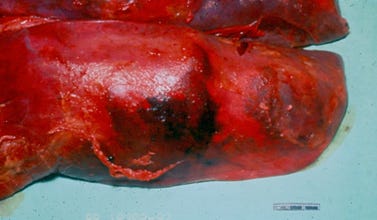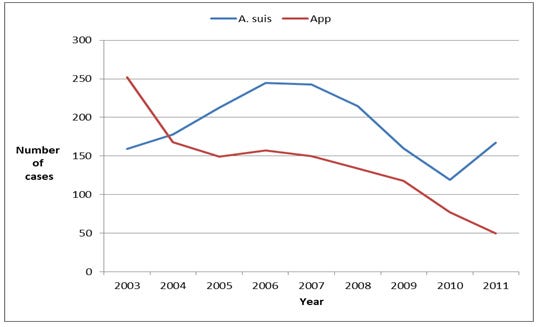June 4, 2012

Actinobacillus suis (A.suis) and Actinobacillus pleuropneumonia (APP) tend to kill pigs quickly and are usually manifested as severe acute pneumonia. Lungs usually have areas that are very firm, hemorrhagic with fibrin present on the surface (Figure 1).

Figure 1. Firm hemorrhagic lungs with fibrin on the surface is characteristic of either Actinobacillus suis or Actinobacillus pleuropneumonia.
Although both species of Actinobacillus can cause similar lesions in lungs, A. suis is a bit more of a chameleon. A.suis can cause septicemia, fibrinous serositis and joint infections that can be easily confused with the clinical signs and lesions of erysipelas, Haemophilus parasuis and Streptococcus suis. A.suis can cause lesions virtually identical to all of these agents and cannot be differentiated without culture and histopathology (tissue examination). Chronic pleuritis and condemnations are increased in survivors.
At the Iowa State University Veterinary Diagnostic Laboratory, the frequency of diagnosis of A.suis exceeds that of erysipelas and APP. Overall, the cases of APP have trended down over the last nine years, but cases of A.suis have remained fairly stable. Indeed, cases of A. suis have exceeded the number of cases of APP since 2005 (Figure 2).

Figure 2. Number of cases of Actinobacillus suis (A. suis) and Actinobacillus pleuropneumonia (APP) at the Iowa State University Veterinary Diagnostic Laboratory from 2003-2011.
Both APP and A.suis cases tend to occur in the later grower period (e.g., 12-16 weeks), with most cases between 9 and 20 weeks of age. The age distribution (based on the percent of cases per age group) is virtually identical for APP and A. suis. However, it is noteworthy that A. suis can also affect suckling and weaned piglets, often manifested as sudden death (septicemia).
Control Measures
Effective control requires an accurate diagnosis. Polymerase chain reaction (PCR) assays are available in some laboratories to rapidly detect the presence of APP and A. suis. Consult your laboratory for preferred specimens and appropriate sampling strategies.
Summer heat can compromise sample quality as tissues and infectious agents deteriorate very quickly. Samples should be taken only from very fresh tissue, preferably from clinically affected, euthanized pigs.
Remember to collect samples on ice and ship on ice. The time from fresh tissue to chilled or formalinized samples should be measured in minutes (less than 20 minutes).
You May Also Like



